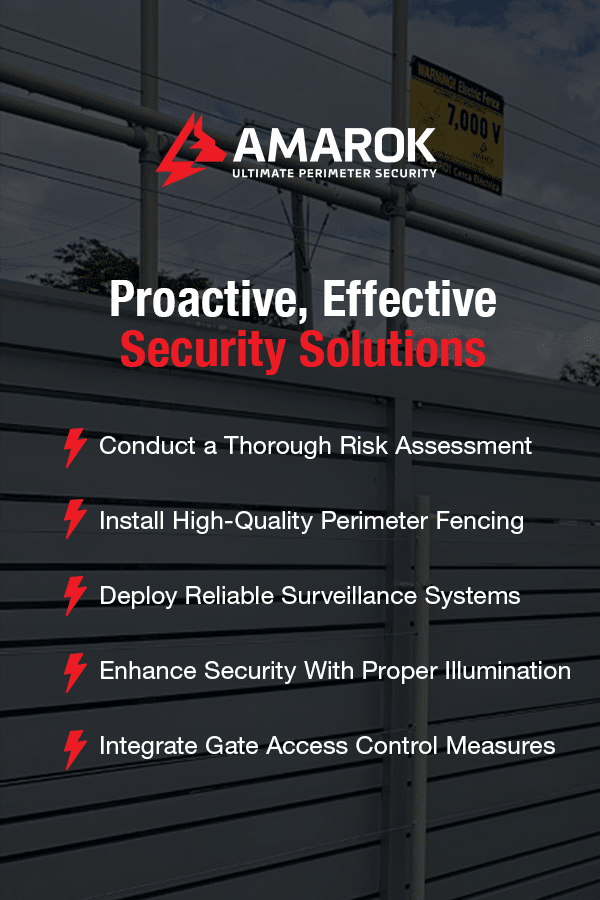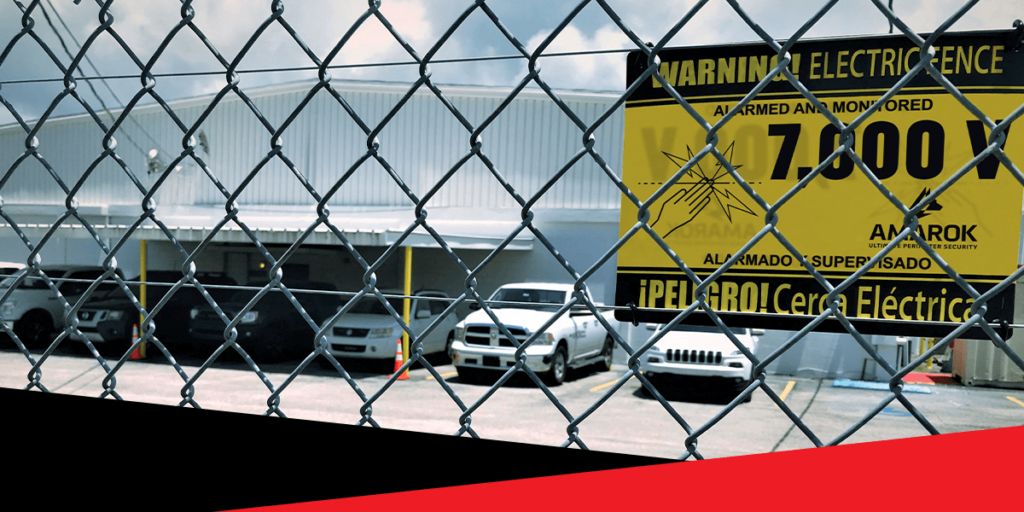In the world of perimeter security, knowledge is power. To effectively safeguard a business, it is essential to be aware of how criminals choose their targets and what factors can make a property an appealing mark. Criminals are drawn to businesses by opportunity, weak defenses, and perceived rewards. They meticulously plan their moves to exploit vulnerabilities.
Understanding what type of places get robbed the most and a thief’s typical mindset can help organizations anticipate and mitigate the risks that make their properties vulnerable. Armed with this insight, taking proactive steps to deter theft and protect valuable assets is easier.
Understanding the Criminal Mindset
Criminals look for targets that balance low risk with high reward. Situations, where they can operate unnoticed or avoid suspicion, are more appealing, as are properties with a greater potential reward from the items they may steal. Based on these preferences, they will target specific sites and exploit their security vulnerabilities. Businesses that are robbed the most are those with valuable goods, minimal on-site security, and expensive equipment present. Examples include warehouses, construction sites, distribution centers, and transport sites.
Research from criminal psychology experts indicates that the primary drivers of theft are psychological and environmental. One common contribution to the criminal mindset can be financial desperation. Some criminals may steal to cover personal expenses or debts, targeting items they can sell quickly.
Organized theft is another major concern for businesses. Thieves often intercept shipments because they know logistics companies frequently park unsecured trailers overnight. Target selection is often based on these visible vulnerabilities. Criminals are noted to have frequently scouted locations beforehand as well, observing patterns and noting weaknesses. Savvier criminals will conduct a rudimentary cost-benefit analysis before acting, weighing the likelihood of getting caught against the potential payoff.
5 Qualities That Attract Criminals
How do criminals target businesses? Thieves tend to be opportunistic, and certain conditions make a property a prime target. Professional thieves often plan heists to steal high-value goods for the resell market. Warehouses storing electronics, copper, or other high-value items are prime targets for these criminal theft rings.
Certain businesses get robbed more often or are more exposed to risks because of the five key elements that attract thieves. From weak access points to inadequate lighting and other lacking security measures, here are concerns to address to make your property less appealing to would-be criminals:
1. Access Point Weakness
Unsecured or poorly managed access points are common vulnerabilities that compromise business security. By leaving entry points unmonitored, you make it easier for opportunistic thieves to gain access. Criminals look for these gaps to enter and exit quickly:
- Uncontrolled entry points: Open gates or unlocked doors facilitate unauthorized access. Businesses without keycard or badge systems face increased risk.
- Shared entryways: Locations with multiple tenants or shared facilities often lack reliable access control, increasing opportunities for security breaches.
- Single-lock systems: Relying on basic locks without additional measures like deadbolts or smart systems weakens defenses. Thieves may breach weak locks on storage units, gaining access to valuable materials or tools.

2. Lighting and Visibility Challenges
Proper lighting is essential for deterring criminal activity, increasing visibility, and reducing hiding spots. Insufficient lighting or poor illumination practices create vulnerabilities:
- Dark zones: Poorly lit areas like parking lots or near loading docks allow criminals to work undetected.
- Inconsistent lighting: Flickering or unreliable fixtures reduce deterrence and create opportunities for trespassers to gain access unnoticed.
- Incorrect placement: Lighting positioned too high or too low can create shadows or glare, limiting effectiveness.
Businesses can combat lighting issues by installing strategically placed lights to illuminate key areas without creating shadows.
3. Inadequate Security Measures
Lax security measures like limited video surveillance or weak perimeter fencing make businesses appear more vulnerable. Criminals will look for gaps they can exploit with minimal risks, including low or damaged fences, unsecured access points, and a lack of surveillance cameras, motion sensors, or security patrols. The absence of visible security cameras attracts criminals because of:
- Limited risk of identification: Without cameras, there is no visual evidence to help law enforcement identify and prosecute offenders.
- Unmonitored blind spots: Areas without camera coverage provide ideal entry points for criminals to break in or steal assets without fear of being seen.
- Perceived neglect: A lack of visible security measures from the outside suggests a business may also be lax in other areas, signaling to criminals that the property is vulnerable.
4. Environmental Factors and Location
Environmental design plays a pivotal role in deterring crime. A poorly planned layout can create blind spots where criminals can hide, obscure sightlines, and invite intrusion. Buildings without clear sightlines to entryways or parking lots increase concealment opportunities for criminals. The same goes for overgrown landscaping, as tall shrubs, trees, or unmaintained greenery can obscure security cameras and provide hiding places. A disorganized layout, such as a trucking yard with stacked containers, can block views of key areas and make it easier for criminals to operate unnoticed.
Sites in isolated areas or without active monitoring are also attractive to would-be criminals because they come with a reduced risk of detection. A remote location may delay law enforcement response times as well, highlighting the importance of adequate perimeter security as a criminal deterrent.
5. Predictable Routines
Consistent schedules and patterns can help criminals plan their actions with precision. The same goes for predictable downtime, like weekends, overnight periods, or seasonal decreases in activity. This routine makes it easy for criminals to plan a potential heist during a time when they are least likely to be caught. When these timetables are coupled with a lack of patrol variation, criminals can easily plan their activities around them.
Disrupting predictable patterns can thwart criminal planning. For example, varying delivery and maintenance schedules or having any on-site security patrols operate irregularly can create uncertainty for would-be thieves.

Indicators of Potential Criminal Activity
Criminals often leave subtle signs while scoping out a target. Recognizing these warning signals can enable security personnel and employees to act before criminal activity occurs:
- Unfamiliar vehicles or loiterers: Watch for cars parked in odd locations or people loitering near the business for extended periods.
- Repeated drive-bys: Vehicles passing by multiple times, especially at irregular hours, may indicate that someone is studying the business’s routines.
- Tampered security equipment: Signs of damage to or interference with locks, cameras, or fences suggest that someone is testing the perimeter defenses.
- Unusual questions or interest: Be cautious of individuals inquiring about security measures, delivery schedules, or access points under the guise of business.
- Markings or tags: Graffiti, chalk markings, or other symbols near entry points can sometimes indicate that an area has been targeted.
Proactive, Effective Security Solutions

Understanding how criminals think is only half the battle. The other half is implementing effective solutions to deter them. Situational crime prevention (SCP) is often used to prevent casualties in violent crimes, but the principle can extend to theft. Organizations can mitigate theft risks by hardening the target, or taking steps to make robbing their premises more difficult or impossible.
To address the elements that attract theft and make their properties less appealing to would-be thieves, businesses should invest in layered security measures that combine a robust perimeter, access control, alarms, and monitoring for comprehensive protection. Doing so starts with requesting a professional risk assessment to determine the property’s unique vulnerabilities.
Conduct a Thorough Risk Assessment
Before implementing any security solutions, a service provider will conduct a thorough risk assessment to identify specific security concerns. After gathering this information, they will craft a tailored security plan that addresses the property’s needs. These plans account for the following factors:
- Property layout: The size, design, and location of the facility determine vulnerable areas like blind spots and entry points.
- Industry risks: Each industry faces unique challenges. Warehousing operations may be concerned with high-value goods, while construction sites are often targeted for tools and machinery.
- Current security measures: Existing barriers, lighting, and surveillance systems will be evaluated to identify areas for improvement.
- Historic data: Professionals will review past incidents like break-ins or vandalism to gain insight into patterns and potential weak points.
- Operational schedules: Understanding employee shifts, delivery times, and peak activity hours allows for strategic security solution deployment.
Install High-Quality Perimeter Fencing
A durable, tamper-resistant fence is the first line of defense. Opt for fencing solutions with anti-climb features, like tightly spaced pickets or welded mesh panels. Adding an electric perimeter fence to complement the existing fence provides a valuable layer of security between potential criminals and valuable assets. An electric fence acts as a physical barrier, delivers a safe but memorable shock on contact, and can integrate with alarms and lights to call attention to criminal actions.
Seeing an electric fence is a major psychological deterrent, as criminals would rather bypass such a formidable boundary. Some premium models run on solar power, which ensures that perimeters are protected even during a power outage. An electric fence is the backbone of physical security measures, especially when used as the heart of a multi-layered security posture.
Deploy Reliable Surveillance Systems
Modern surveillance systems do more than record video — they are a good addition to a comprehensive security system, as some would-be criminals are less likely to act if they know there will be video evidence. Place high-definition cameras in visible locations and integrate trigger alarms to send alerts to security teams in real time. Pair cameras with signage that clearly state the property is under surveillance.
Backing up video surveillance footage allows for easy sharing with law enforcement, which helps expedite response time if police require video proof before responding to a potential incident. Video surveillance also allows for monitoring daily operations, helping security personnel maintain a safe environment for visitors and employees.
Enhance Security With Proper Illumination
Well-lit properties are far less attractive to criminals. Install bright, energy-efficient LED floodlights at key points, including around the fence line, at loading docks, and near parking areas. This measure will eliminate shadows and increase visibility. Alarm-based lighting can further surprise and deter intruders by signaling that the business is actively monitored.
Pathway lighting enhances both security and aesthetics while guiding employees and visitors safely. Another option is to install dawn-to-dusk lights, which automatically activate at night and turn off during the day. This automation ensures consistent illumination without requiring manual operation. Commercial security lighting is a valuable part of a layered security system, especially for remote or otherwise vulnerable properties.
Integrate Gate Access Control Measures
Heavy equipment, tools, and inventory should be stored in a secure enclosure inside locked buildings whenever possible. Use heavy-duty locks or GPS-enabled tracking devices on vehicles and machinery for outdoor storage. Gate access control measures are a powerful way to deter unauthorized entry and protect assets. These systems come in numerous configurations and restrict access while providing a clear record of who enters and exits the property. Access control technologies include:
- Keycard and code access: Only authorized personnel can enter designated areas, reducing the risk of trespassing or internal theft.
- Remote gate management: Automated gates equipped with remote access control and intercom systems allow for secure, efficient entry point management.
- Visitor management systems: Digital logs track visitors in real time, making it easier to monitor and audit access.
- Time-sensitive access: Temporary access codes or keycards ensure contractors and vendors can only enter during approved hours.
Stop Business Theft With AMAROK
Mitigating physical vulnerabilities and other qualities that attract criminals to businesses requires thoughtful planning, regular assessments, and investments in security infrastructure. Addressing these gaps strengthens physical defenses to deter criminal activity. An integrated security system combining high-quality electric fencing, access control, and lighting is the first step to staying ahead of criminal intentions.
At AMAROK, we specialize in providing comprehensive perimeter security solutions tailored to your business. Our expertise helps your operation mitigate risks and protect its most valuable assets. At the heart of our service is our flagship solution, The Electric Guard Dog™ Fence, which eliminates the need for on-site security guards and stops 99% of external theft after installation. We can also provide video surveillance, lighting, and other security resources to establish a multi-layered security posture and address your property’s specific vulnerabilities.
AMAROK is a security-as-a-service provider, meaning we help your business secure its perimeter with zero upfront costs — you pay only a manageable monthly fee. Request your threat assessment today or call (803) 786-6333 for more information.





